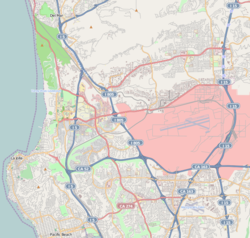Welcome to my sandbox.
El Montón (SCRI-333) is a large mound built by the Chumash people on Santa Cruz island between 6000 and 2500 BCE.[1][2]
| Location | Santa Cruz Island, California |
|---|---|
| Type | Ceremonial Mound |
Convoy District | |
|---|---|
| Convoy Pan Asian Cultural & Business Innovation District | |
 Convoy Street in Kearny Mesa | |
| Coordinates: 32°49′36″N 117°09′16″W / 32.826788°N 117.154327°W | |
| Country | |
| State | |
| County | |
| City | |
Convoy District is a neighborhood in Kearny Mesa, San Diego. It is distinguished by the number of diverse businesses owned and representative of different Asian cultures such as Chinese, Korean, Japanese, Vietnamese, and Thai shopping and eating establishments. T
Some of these extend to the east/central areas (near Balboa Avenue, along State Route 163).
Geography
editThe district is located along Convoy Street in the triangle formed by Interstate 805 and California State Routes 163 and 52 south of MCAS Miramar. It is a part of the larger Kearny Mesa planning group.[3]
History
editThere were few Asian establishments in the area until the late 1960s.
Utilities in the district along Convoy street were damaged during the 1995 theft of an M60 tank from a National Guard armory.[4]
On October 20, 2020 Convoy District was designated as the Convoy Pan Asian Cultural & Business Innovation District after local businesses, tenants, storeowners, and non profit organizations pushed for an official renaming.[5] As a center of pan-Asian culture in San Diego, numerous community groups are active in the district. Convoy District Partnership, one of these organizations, helped fundraise over $30,000 to help create highway signs to promote the district.[6]
The presence of Asian businesses in the Convoy District area is said to have started with the establishment of a Woo Chee Chong grocery store on Convoy Street in 1979.[8] The Korean market chain Zion opened its first store in the Convoy District, also in 1979.[8] A few years later, in 1986, Nijiya Market (a Japanese market located in the southwestern portion of the Convoy District), opened its very first store; it later expanded to more than ten locations in California and Hawaii.[9] These early establishments served as small anchors, and additional Asian shops and restaurants opened nearby. As the area's reputation for its Asian cuisine and merchandise grew, more widely established Asian chain stores such as 99 Ranch Market, Mitsuwa, and H Mart also began setting up sites in the Convoy District.[8]
References
edit- ^ Gamble, Lynn H. (July 2017). "FEASTING, RITUAL PRACTICES, SOCIAL MEMORY, AND PERSISTENT PLACES: NEW INTERPRETATIONS OF SHELL MOUNDS IN SOUTHERN CALIFORNIA". American Antiquity. 82 (3): 427–451 – via JSTOR.
- ^ Glassnow, Michael (December 2010). "CHANNEL ISLANDS NATIONAL PARK ARCHAEOLOGICAL OVERVIEW AND ASSESSMENT" (PDF).
- ^ "About Convoy District". Convoy District. Retrieved 2024-09-01.
- ^ LaVelle, Philip J.; Dibsie, Patricia (1995-05-18). "Tank Rampage Here: Stolen 57-ton vehicle leaves ruin in its tracks". The San Diego Union-Tribune. pp. A-1 & A-17. ISSN 1063-102X.
Clairemont plumber killed by police gunfire; Route 163 traffic snarled
- ^ Wu, Sabrina (November 1, 2020), "San Diego Convoy District Designated as Pan-Asian Cultural and Business Hub", UCSD Guardian
- ^ Rendon-Alvarez, Karla; Gomez • •, Nicole. "New Freeway Signs Will Guide Drivers to Convoy District". NBC 7 San Diego. Retrieved 2022-10-21.
- ^ Marx, Jesse (2022-10-03). "Council Race to Test the Voting Power of Asian Empowerment District". Voice of San Diego. Retrieved 2022-10-21.
- ^ a b c Johnson, Troy (2021-05-27). "How Convoy Became the Heart of San Diego's Asian Food Scene". San Diego Magazine.
- ^ Goto, Asami (2013-10-18). ""Shokuiku" activities at Nijiya Market Thinking about the future of shokuiku activities that pass on the Japanese food culture in America". www.discovernikkei.org.

